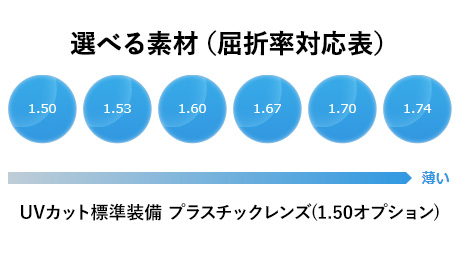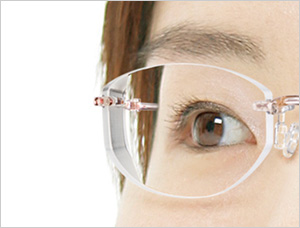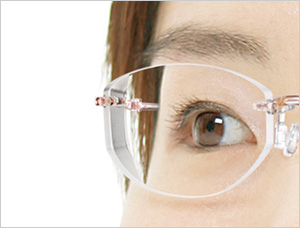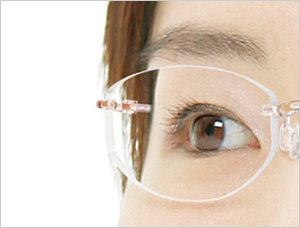044-722-4262
3-600 Kosugi-cho, Nakahara-ku, Kawasaki-shi, Kanagawa
Kosugi 3rd Avenue 1F
Business hours: 10:00-19:00
Lenses
fixed focal length lens
This is the basic lens for farsightedness/myopia/astigmatism/presbyopia.
There are several types of single vision lenses. The lens we recommend will depend on your power, your age, and your experience with spectacles. We will suggest the most suitable lens for you. So, what should we pay attention to when choosing a lens?
There are three selection criteria for choosing a single focus.
1. Refractive index
2. Lens design
3. Abbe number
The customer will choose the "refractive index" and "lens design" among them.
The Abbe number is a selection criterion tied to the refractive index, so it is not used as a criterion for selection.
1. About refractive indices
The refractive index is a measure of lens thinness. We use materials with a refractive index of 1.50, 1.53, 1.60, 1,67 and 1.74. The higher the refractive index, the thinner the lens, but the transparency is slightly lower, so we do not recommend the use of high refractive index lenses, which are called ultra-thin lenses, unless it is truly necessary for people with strong myopia or strong hyperopia.
We will suggest appropriate lenses according to the power of the lens.


2. Lens design
Lens design, so to speak, is the difference in the way lenses are made. Lenses with a wide viewing range and low distortion have a lot of correction applied to them to improve vision. However, since there are individual differences in the feeling of wearing lenses, we will make suggestions based on the power of the lens.
(1) Custom-made lenses
These are the only custom-made lenses in the world that are made to fit each customer's frame shape after measuring the anterior tilt angle, tilt angle, and distance between corneal vertices.
(2) Double-sided aspheric design
This is a premium lens with a wide effective field of view by applying an aspheric design to both the front and back sides of the lens. This lens is used for frames with shallow frame curves.
(3) Inner surface aspheric design
This is a premium lens with a wide effective field of view by applying an aspheric design to the back of the lens. This lens is used for frames with deep frame curves.
(4) Outer surface aspheric design
By applying an aspheric design to the front surface of the lens, peripheral distortion is minimized. Most single vision lenses sold in Japan have an aspherical outer surface.
We will suggest appropriate lenses according to the power of the lens.
Viewing Image
-
Outer surface aspheric design


-
Inner surface aspheric design


-
Double-sided aspheric design


Sharp-looking boundary area (image is for reference only)
Face line impression is also smartened.
-
Spherical design


-
Outer surface aspheric design


-
Double-sided aspheric design



